Sasol: Strategic Decision Making in the Global Business Environment
VerifiedAdded on 2023/06/12
|11
|3108
|64
Report
AI Summary
This report provides an analysis of the global business environment with a focus on strategic decision-making, using Sasol as a case study. It explores the company's structure, culture, and governance through McKinsey's 7S model, evaluating how global operations have influenced these aspects and how Sasol has adapted to the international market. The report also examines the ethical and sustainable factors that Sasol must consider, along with a critical evaluation of strategic decision-making in relation to risk and diversification. Furthermore, it assesses different strategic global expansion routes available to the company, offering a comprehensive overview of Sasol's approach to navigating the complexities of the global business landscape. Desklib provides access to similar solved assignments and study tools for students.
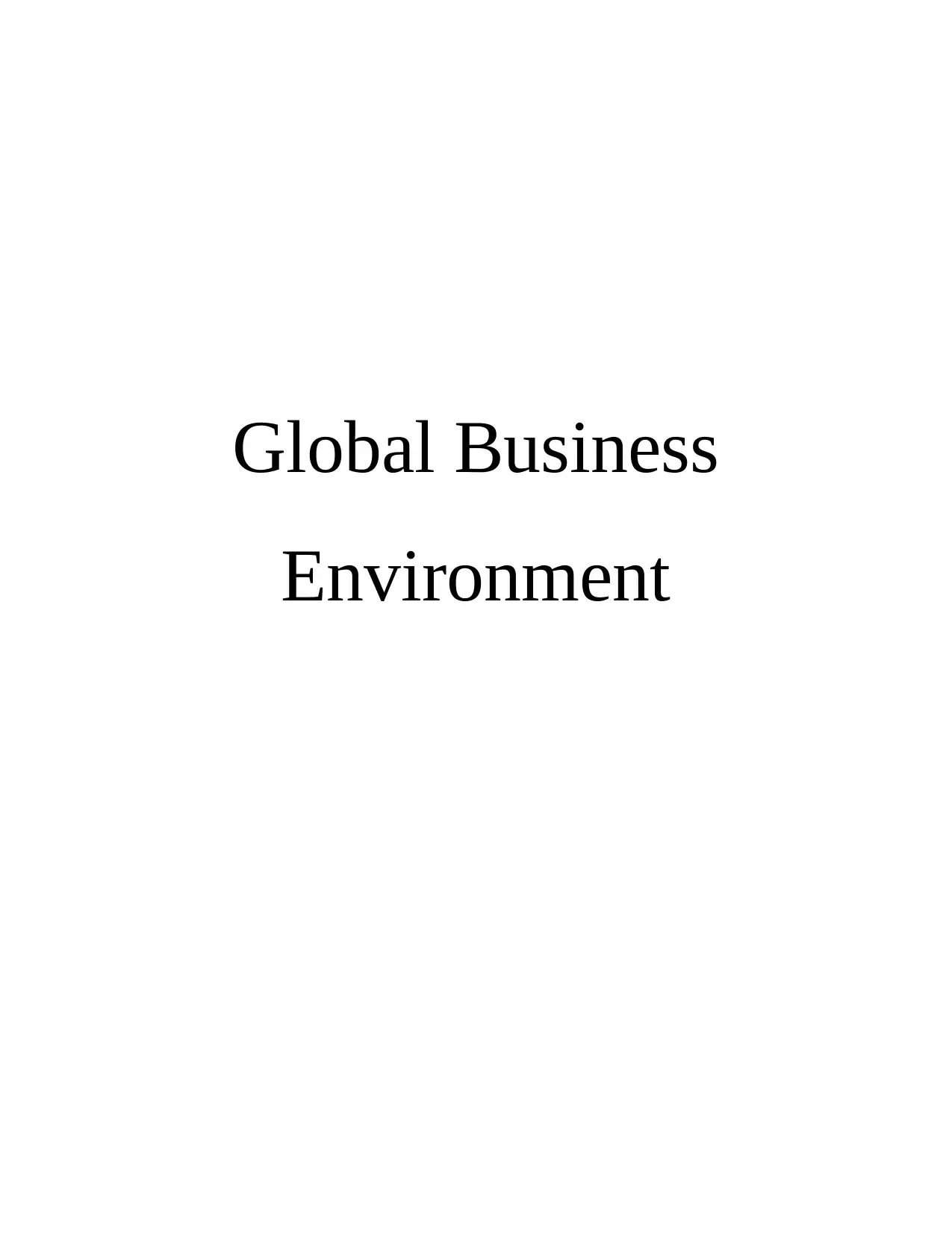
Global Business
Environment
Environment
Paraphrase This Document
Need a fresh take? Get an instant paraphrase of this document with our AI Paraphraser
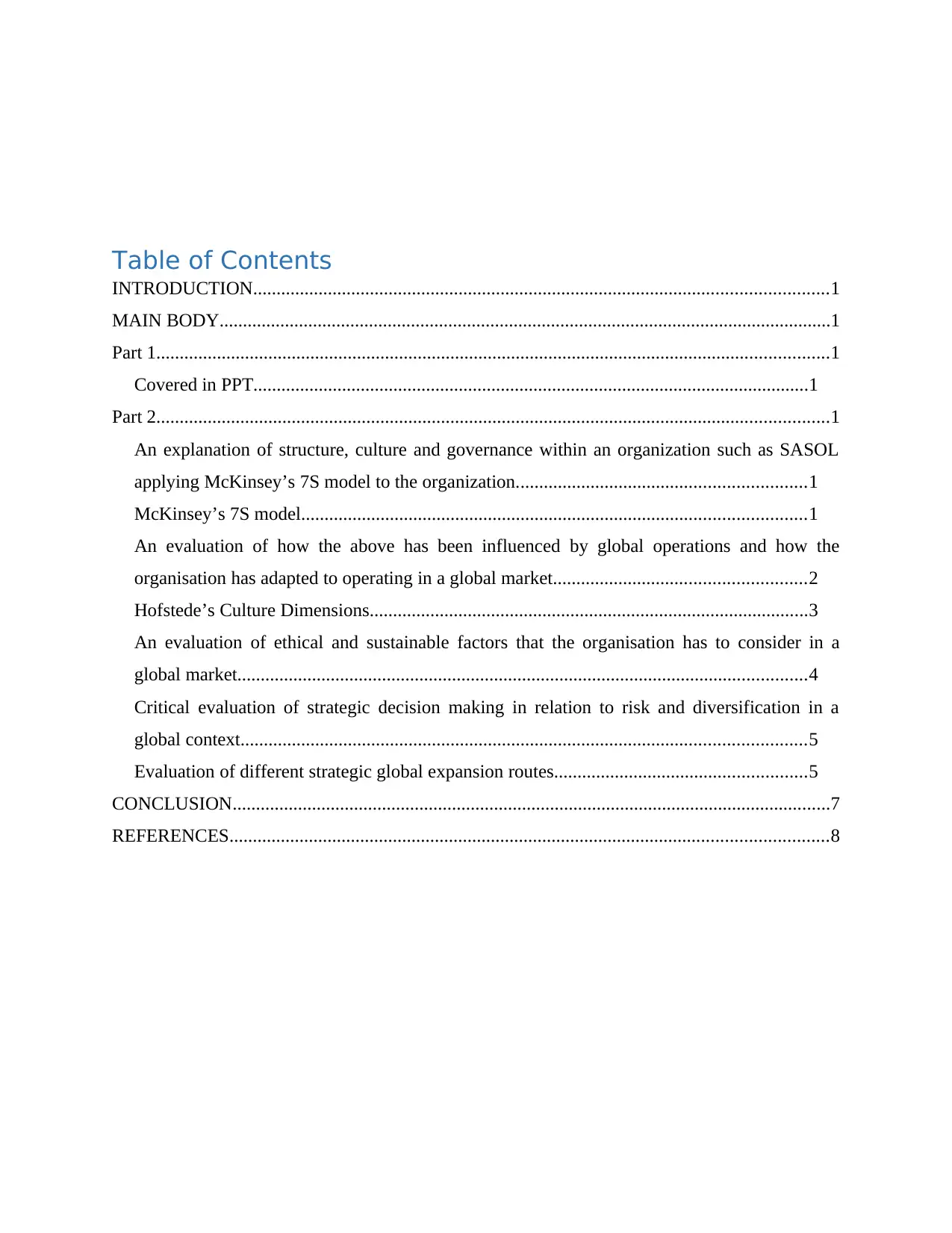
Table of Contents
INTRODUCTION...........................................................................................................................1
MAIN BODY...................................................................................................................................1
Part 1................................................................................................................................................1
Covered in PPT.......................................................................................................................1
Part 2................................................................................................................................................1
An explanation of structure, culture and governance within an organization such as SASOL
applying McKinsey’s 7S model to the organization..............................................................1
McKinsey’s 7S model............................................................................................................1
An evaluation of how the above has been influenced by global operations and how the
organisation has adapted to operating in a global market......................................................2
Hofstede’s Culture Dimensions..............................................................................................3
An evaluation of ethical and sustainable factors that the organisation has to consider in a
global market..........................................................................................................................4
Critical evaluation of strategic decision making in relation to risk and diversification in a
global context.........................................................................................................................5
Evaluation of different strategic global expansion routes......................................................5
CONCLUSION................................................................................................................................7
REFERENCES................................................................................................................................8
INTRODUCTION...........................................................................................................................1
MAIN BODY...................................................................................................................................1
Part 1................................................................................................................................................1
Covered in PPT.......................................................................................................................1
Part 2................................................................................................................................................1
An explanation of structure, culture and governance within an organization such as SASOL
applying McKinsey’s 7S model to the organization..............................................................1
McKinsey’s 7S model............................................................................................................1
An evaluation of how the above has been influenced by global operations and how the
organisation has adapted to operating in a global market......................................................2
Hofstede’s Culture Dimensions..............................................................................................3
An evaluation of ethical and sustainable factors that the organisation has to consider in a
global market..........................................................................................................................4
Critical evaluation of strategic decision making in relation to risk and diversification in a
global context.........................................................................................................................5
Evaluation of different strategic global expansion routes......................................................5
CONCLUSION................................................................................................................................7
REFERENCES................................................................................................................................8
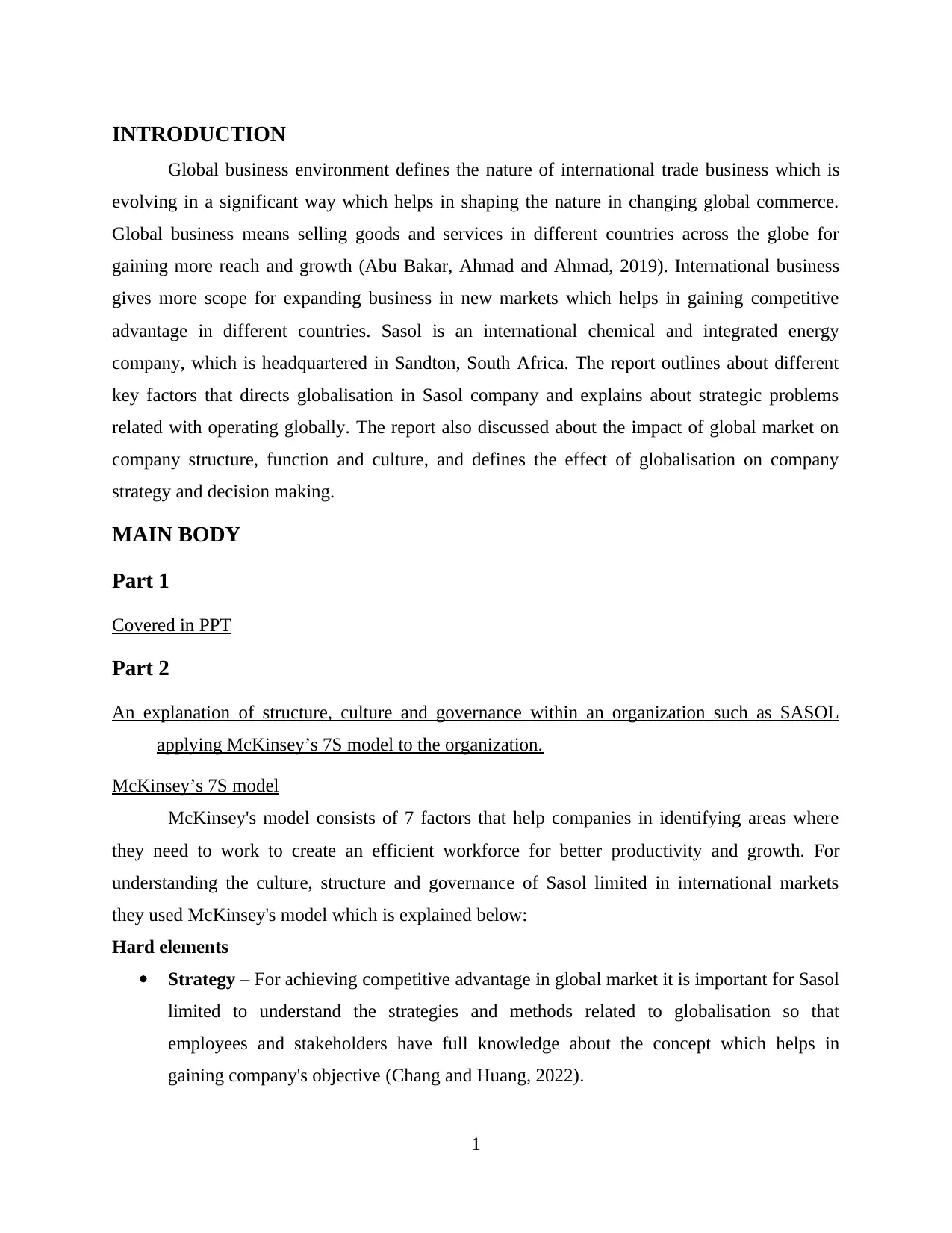
INTRODUCTION
Global business environment defines the nature of international trade business which is
evolving in a significant way which helps in shaping the nature in changing global commerce.
Global business means selling goods and services in different countries across the globe for
gaining more reach and growth (Abu Bakar, Ahmad and Ahmad, 2019). International business
gives more scope for expanding business in new markets which helps in gaining competitive
advantage in different countries. Sasol is an international chemical and integrated energy
company, which is headquartered in Sandton, South Africa. The report outlines about different
key factors that directs globalisation in Sasol company and explains about strategic problems
related with operating globally. The report also discussed about the impact of global market on
company structure, function and culture, and defines the effect of globalisation on company
strategy and decision making.
MAIN BODY
Part 1
Covered in PPT
Part 2
An explanation of structure, culture and governance within an organization such as SASOL
applying McKinsey’s 7S model to the organization.
McKinsey’s 7S model
McKinsey's model consists of 7 factors that help companies in identifying areas where
they need to work to create an efficient workforce for better productivity and growth. For
understanding the culture, structure and governance of Sasol limited in international markets
they used McKinsey's model which is explained below:
Hard elements
Strategy – For achieving competitive advantage in global market it is important for Sasol
limited to understand the strategies and methods related to globalisation so that
employees and stakeholders have full knowledge about the concept which helps in
gaining company's objective (Chang and Huang, 2022).
1
Global business environment defines the nature of international trade business which is
evolving in a significant way which helps in shaping the nature in changing global commerce.
Global business means selling goods and services in different countries across the globe for
gaining more reach and growth (Abu Bakar, Ahmad and Ahmad, 2019). International business
gives more scope for expanding business in new markets which helps in gaining competitive
advantage in different countries. Sasol is an international chemical and integrated energy
company, which is headquartered in Sandton, South Africa. The report outlines about different
key factors that directs globalisation in Sasol company and explains about strategic problems
related with operating globally. The report also discussed about the impact of global market on
company structure, function and culture, and defines the effect of globalisation on company
strategy and decision making.
MAIN BODY
Part 1
Covered in PPT
Part 2
An explanation of structure, culture and governance within an organization such as SASOL
applying McKinsey’s 7S model to the organization.
McKinsey’s 7S model
McKinsey's model consists of 7 factors that help companies in identifying areas where
they need to work to create an efficient workforce for better productivity and growth. For
understanding the culture, structure and governance of Sasol limited in international markets
they used McKinsey's model which is explained below:
Hard elements
Strategy – For achieving competitive advantage in global market it is important for Sasol
limited to understand the strategies and methods related to globalisation so that
employees and stakeholders have full knowledge about the concept which helps in
gaining company's objective (Chang and Huang, 2022).
1
⊘ This is a preview!⊘
Do you want full access?
Subscribe today to unlock all pages.

Trusted by 1+ million students worldwide
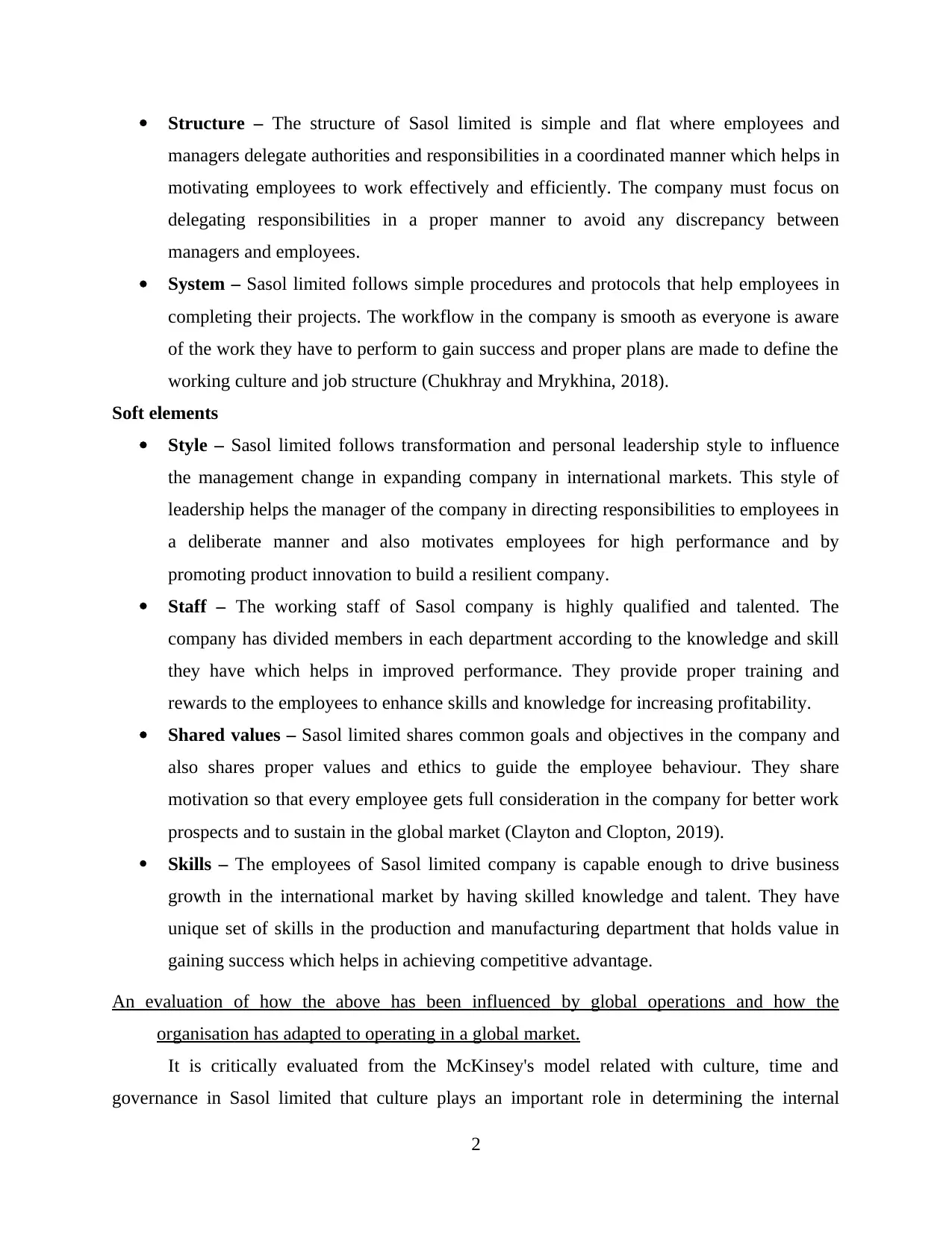
Structure – The structure of Sasol limited is simple and flat where employees and
managers delegate authorities and responsibilities in a coordinated manner which helps in
motivating employees to work effectively and efficiently. The company must focus on
delegating responsibilities in a proper manner to avoid any discrepancy between
managers and employees.
System – Sasol limited follows simple procedures and protocols that help employees in
completing their projects. The workflow in the company is smooth as everyone is aware
of the work they have to perform to gain success and proper plans are made to define the
working culture and job structure (Chukhray and Mrykhina, 2018).
Soft elements
Style – Sasol limited follows transformation and personal leadership style to influence
the management change in expanding company in international markets. This style of
leadership helps the manager of the company in directing responsibilities to employees in
a deliberate manner and also motivates employees for high performance and by
promoting product innovation to build a resilient company.
Staff – The working staff of Sasol company is highly qualified and talented. The
company has divided members in each department according to the knowledge and skill
they have which helps in improved performance. They provide proper training and
rewards to the employees to enhance skills and knowledge for increasing profitability.
Shared values – Sasol limited shares common goals and objectives in the company and
also shares proper values and ethics to guide the employee behaviour. They share
motivation so that every employee gets full consideration in the company for better work
prospects and to sustain in the global market (Clayton and Clopton, 2019).
Skills – The employees of Sasol limited company is capable enough to drive business
growth in the international market by having skilled knowledge and talent. They have
unique set of skills in the production and manufacturing department that holds value in
gaining success which helps in achieving competitive advantage.
An evaluation of how the above has been influenced by global operations and how the
organisation has adapted to operating in a global market.
It is critically evaluated from the McKinsey's model related with culture, time and
governance in Sasol limited that culture plays an important role in determining the internal
2
managers delegate authorities and responsibilities in a coordinated manner which helps in
motivating employees to work effectively and efficiently. The company must focus on
delegating responsibilities in a proper manner to avoid any discrepancy between
managers and employees.
System – Sasol limited follows simple procedures and protocols that help employees in
completing their projects. The workflow in the company is smooth as everyone is aware
of the work they have to perform to gain success and proper plans are made to define the
working culture and job structure (Chukhray and Mrykhina, 2018).
Soft elements
Style – Sasol limited follows transformation and personal leadership style to influence
the management change in expanding company in international markets. This style of
leadership helps the manager of the company in directing responsibilities to employees in
a deliberate manner and also motivates employees for high performance and by
promoting product innovation to build a resilient company.
Staff – The working staff of Sasol company is highly qualified and talented. The
company has divided members in each department according to the knowledge and skill
they have which helps in improved performance. They provide proper training and
rewards to the employees to enhance skills and knowledge for increasing profitability.
Shared values – Sasol limited shares common goals and objectives in the company and
also shares proper values and ethics to guide the employee behaviour. They share
motivation so that every employee gets full consideration in the company for better work
prospects and to sustain in the global market (Clayton and Clopton, 2019).
Skills – The employees of Sasol limited company is capable enough to drive business
growth in the international market by having skilled knowledge and talent. They have
unique set of skills in the production and manufacturing department that holds value in
gaining success which helps in achieving competitive advantage.
An evaluation of how the above has been influenced by global operations and how the
organisation has adapted to operating in a global market.
It is critically evaluated from the McKinsey's model related with culture, time and
governance in Sasol limited that culture plays an important role in determining the internal
2
Paraphrase This Document
Need a fresh take? Get an instant paraphrase of this document with our AI Paraphraser
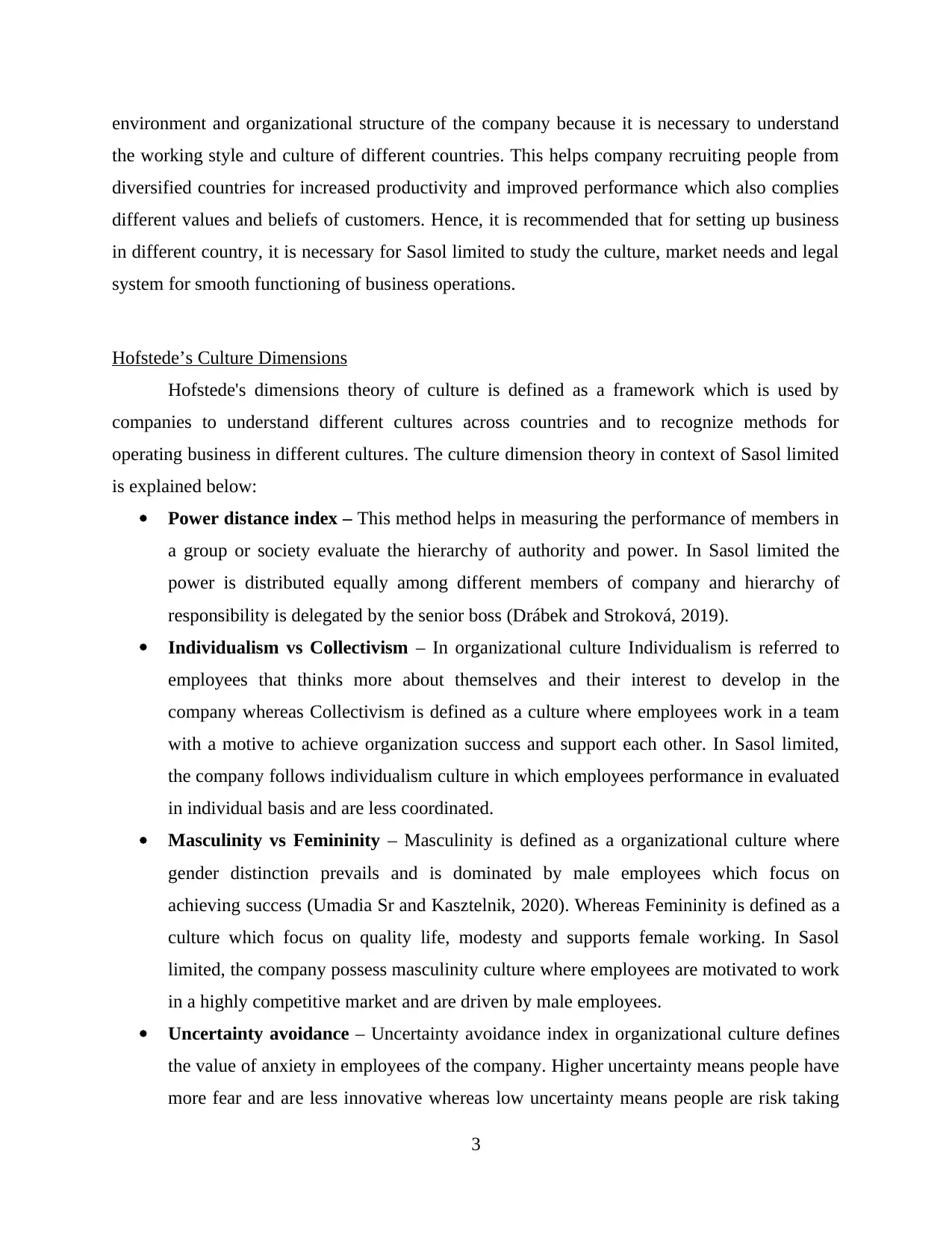
environment and organizational structure of the company because it is necessary to understand
the working style and culture of different countries. This helps company recruiting people from
diversified countries for increased productivity and improved performance which also complies
different values and beliefs of customers. Hence, it is recommended that for setting up business
in different country, it is necessary for Sasol limited to study the culture, market needs and legal
system for smooth functioning of business operations.
Hofstede’s Culture Dimensions
Hofstede's dimensions theory of culture is defined as a framework which is used by
companies to understand different cultures across countries and to recognize methods for
operating business in different cultures. The culture dimension theory in context of Sasol limited
is explained below:
Power distance index – This method helps in measuring the performance of members in
a group or society evaluate the hierarchy of authority and power. In Sasol limited the
power is distributed equally among different members of company and hierarchy of
responsibility is delegated by the senior boss (Drábek and Stroková, 2019).
Individualism vs Collectivism – In organizational culture Individualism is referred to
employees that thinks more about themselves and their interest to develop in the
company whereas Collectivism is defined as a culture where employees work in a team
with a motive to achieve organization success and support each other. In Sasol limited,
the company follows individualism culture in which employees performance in evaluated
in individual basis and are less coordinated.
Masculinity vs Femininity – Masculinity is defined as a organizational culture where
gender distinction prevails and is dominated by male employees which focus on
achieving success (Umadia Sr and Kasztelnik, 2020). Whereas Femininity is defined as a
culture which focus on quality life, modesty and supports female working. In Sasol
limited, the company possess masculinity culture where employees are motivated to work
in a highly competitive market and are driven by male employees.
Uncertainty avoidance – Uncertainty avoidance index in organizational culture defines
the value of anxiety in employees of the company. Higher uncertainty means people have
more fear and are less innovative whereas low uncertainty means people are risk taking
3
the working style and culture of different countries. This helps company recruiting people from
diversified countries for increased productivity and improved performance which also complies
different values and beliefs of customers. Hence, it is recommended that for setting up business
in different country, it is necessary for Sasol limited to study the culture, market needs and legal
system for smooth functioning of business operations.
Hofstede’s Culture Dimensions
Hofstede's dimensions theory of culture is defined as a framework which is used by
companies to understand different cultures across countries and to recognize methods for
operating business in different cultures. The culture dimension theory in context of Sasol limited
is explained below:
Power distance index – This method helps in measuring the performance of members in
a group or society evaluate the hierarchy of authority and power. In Sasol limited the
power is distributed equally among different members of company and hierarchy of
responsibility is delegated by the senior boss (Drábek and Stroková, 2019).
Individualism vs Collectivism – In organizational culture Individualism is referred to
employees that thinks more about themselves and their interest to develop in the
company whereas Collectivism is defined as a culture where employees work in a team
with a motive to achieve organization success and support each other. In Sasol limited,
the company follows individualism culture in which employees performance in evaluated
in individual basis and are less coordinated.
Masculinity vs Femininity – Masculinity is defined as a organizational culture where
gender distinction prevails and is dominated by male employees which focus on
achieving success (Umadia Sr and Kasztelnik, 2020). Whereas Femininity is defined as a
culture which focus on quality life, modesty and supports female working. In Sasol
limited, the company possess masculinity culture where employees are motivated to work
in a highly competitive market and are driven by male employees.
Uncertainty avoidance – Uncertainty avoidance index in organizational culture defines
the value of anxiety in employees of the company. Higher uncertainty means people have
more fear and are less innovative whereas low uncertainty means people are risk taking
3
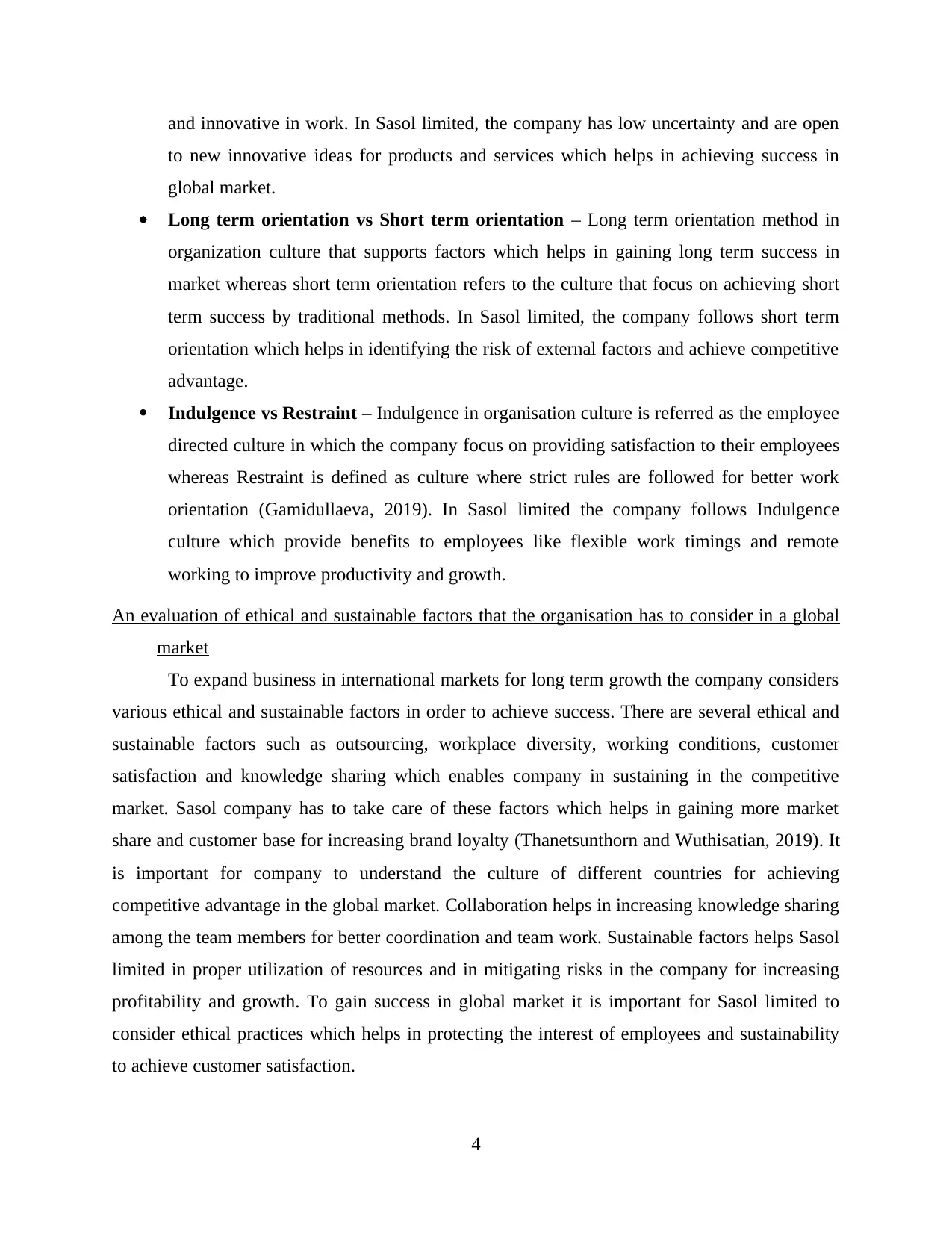
and innovative in work. In Sasol limited, the company has low uncertainty and are open
to new innovative ideas for products and services which helps in achieving success in
global market.
Long term orientation vs Short term orientation – Long term orientation method in
organization culture that supports factors which helps in gaining long term success in
market whereas short term orientation refers to the culture that focus on achieving short
term success by traditional methods. In Sasol limited, the company follows short term
orientation which helps in identifying the risk of external factors and achieve competitive
advantage.
Indulgence vs Restraint – Indulgence in organisation culture is referred as the employee
directed culture in which the company focus on providing satisfaction to their employees
whereas Restraint is defined as culture where strict rules are followed for better work
orientation (Gamidullaeva, 2019). In Sasol limited the company follows Indulgence
culture which provide benefits to employees like flexible work timings and remote
working to improve productivity and growth.
An evaluation of ethical and sustainable factors that the organisation has to consider in a global
market
To expand business in international markets for long term growth the company considers
various ethical and sustainable factors in order to achieve success. There are several ethical and
sustainable factors such as outsourcing, workplace diversity, working conditions, customer
satisfaction and knowledge sharing which enables company in sustaining in the competitive
market. Sasol company has to take care of these factors which helps in gaining more market
share and customer base for increasing brand loyalty (Thanetsunthorn and Wuthisatian, 2019). It
is important for company to understand the culture of different countries for achieving
competitive advantage in the global market. Collaboration helps in increasing knowledge sharing
among the team members for better coordination and team work. Sustainable factors helps Sasol
limited in proper utilization of resources and in mitigating risks in the company for increasing
profitability and growth. To gain success in global market it is important for Sasol limited to
consider ethical practices which helps in protecting the interest of employees and sustainability
to achieve customer satisfaction.
4
to new innovative ideas for products and services which helps in achieving success in
global market.
Long term orientation vs Short term orientation – Long term orientation method in
organization culture that supports factors which helps in gaining long term success in
market whereas short term orientation refers to the culture that focus on achieving short
term success by traditional methods. In Sasol limited, the company follows short term
orientation which helps in identifying the risk of external factors and achieve competitive
advantage.
Indulgence vs Restraint – Indulgence in organisation culture is referred as the employee
directed culture in which the company focus on providing satisfaction to their employees
whereas Restraint is defined as culture where strict rules are followed for better work
orientation (Gamidullaeva, 2019). In Sasol limited the company follows Indulgence
culture which provide benefits to employees like flexible work timings and remote
working to improve productivity and growth.
An evaluation of ethical and sustainable factors that the organisation has to consider in a global
market
To expand business in international markets for long term growth the company considers
various ethical and sustainable factors in order to achieve success. There are several ethical and
sustainable factors such as outsourcing, workplace diversity, working conditions, customer
satisfaction and knowledge sharing which enables company in sustaining in the competitive
market. Sasol company has to take care of these factors which helps in gaining more market
share and customer base for increasing brand loyalty (Thanetsunthorn and Wuthisatian, 2019). It
is important for company to understand the culture of different countries for achieving
competitive advantage in the global market. Collaboration helps in increasing knowledge sharing
among the team members for better coordination and team work. Sustainable factors helps Sasol
limited in proper utilization of resources and in mitigating risks in the company for increasing
profitability and growth. To gain success in global market it is important for Sasol limited to
consider ethical practices which helps in protecting the interest of employees and sustainability
to achieve customer satisfaction.
4
⊘ This is a preview!⊘
Do you want full access?
Subscribe today to unlock all pages.

Trusted by 1+ million students worldwide
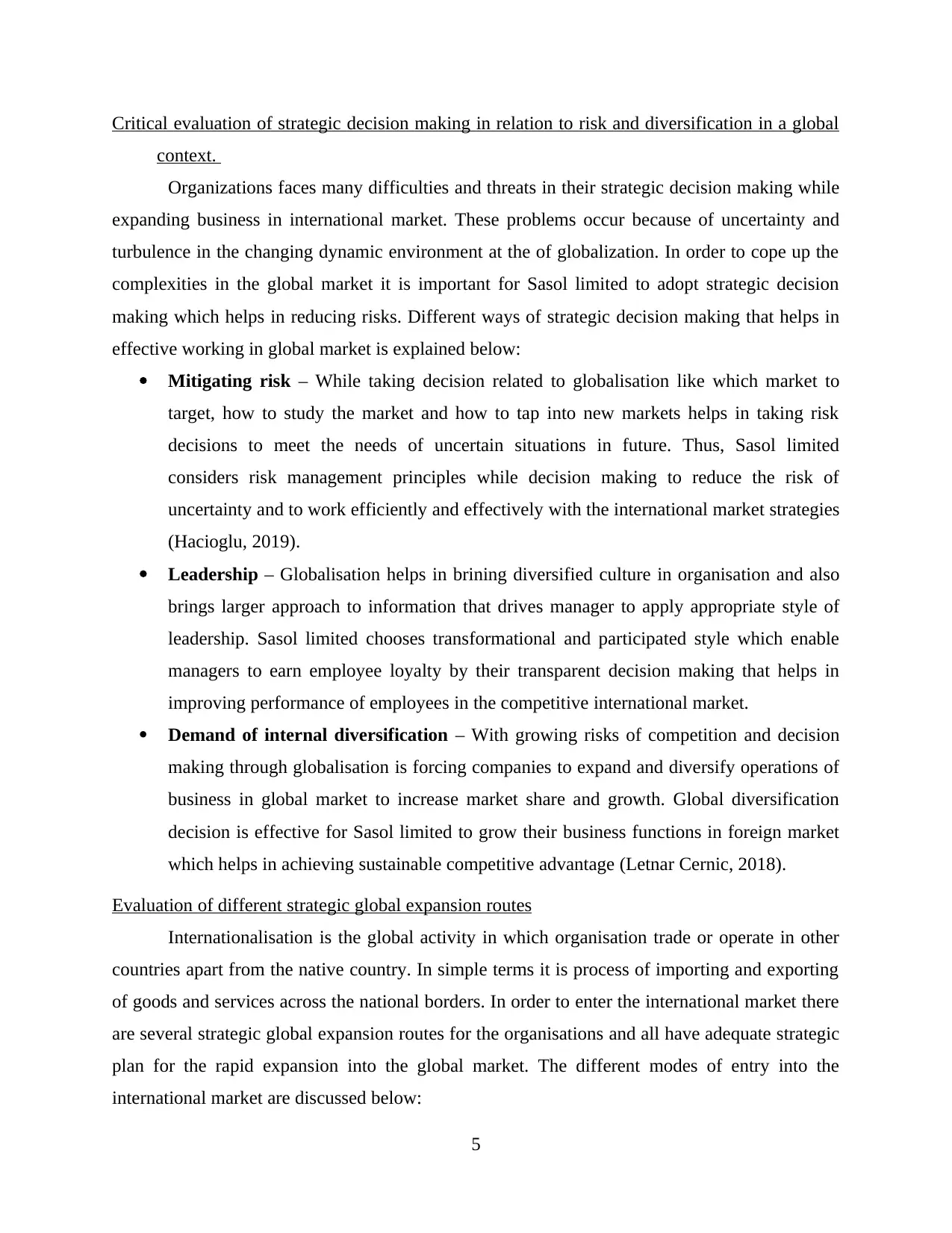
Critical evaluation of strategic decision making in relation to risk and diversification in a global
context.
Organizations faces many difficulties and threats in their strategic decision making while
expanding business in international market. These problems occur because of uncertainty and
turbulence in the changing dynamic environment at the of globalization. In order to cope up the
complexities in the global market it is important for Sasol limited to adopt strategic decision
making which helps in reducing risks. Different ways of strategic decision making that helps in
effective working in global market is explained below:
Mitigating risk – While taking decision related to globalisation like which market to
target, how to study the market and how to tap into new markets helps in taking risk
decisions to meet the needs of uncertain situations in future. Thus, Sasol limited
considers risk management principles while decision making to reduce the risk of
uncertainty and to work efficiently and effectively with the international market strategies
(Hacioglu, 2019).
Leadership – Globalisation helps in brining diversified culture in organisation and also
brings larger approach to information that drives manager to apply appropriate style of
leadership. Sasol limited chooses transformational and participated style which enable
managers to earn employee loyalty by their transparent decision making that helps in
improving performance of employees in the competitive international market.
Demand of internal diversification – With growing risks of competition and decision
making through globalisation is forcing companies to expand and diversify operations of
business in global market to increase market share and growth. Global diversification
decision is effective for Sasol limited to grow their business functions in foreign market
which helps in achieving sustainable competitive advantage (Letnar Cernic, 2018).
Evaluation of different strategic global expansion routes
Internationalisation is the global activity in which organisation trade or operate in other
countries apart from the native country. In simple terms it is process of importing and exporting
of goods and services across the national borders. In order to enter the international market there
are several strategic global expansion routes for the organisations and all have adequate strategic
plan for the rapid expansion into the global market. The different modes of entry into the
international market are discussed below:
5
context.
Organizations faces many difficulties and threats in their strategic decision making while
expanding business in international market. These problems occur because of uncertainty and
turbulence in the changing dynamic environment at the of globalization. In order to cope up the
complexities in the global market it is important for Sasol limited to adopt strategic decision
making which helps in reducing risks. Different ways of strategic decision making that helps in
effective working in global market is explained below:
Mitigating risk – While taking decision related to globalisation like which market to
target, how to study the market and how to tap into new markets helps in taking risk
decisions to meet the needs of uncertain situations in future. Thus, Sasol limited
considers risk management principles while decision making to reduce the risk of
uncertainty and to work efficiently and effectively with the international market strategies
(Hacioglu, 2019).
Leadership – Globalisation helps in brining diversified culture in organisation and also
brings larger approach to information that drives manager to apply appropriate style of
leadership. Sasol limited chooses transformational and participated style which enable
managers to earn employee loyalty by their transparent decision making that helps in
improving performance of employees in the competitive international market.
Demand of internal diversification – With growing risks of competition and decision
making through globalisation is forcing companies to expand and diversify operations of
business in global market to increase market share and growth. Global diversification
decision is effective for Sasol limited to grow their business functions in foreign market
which helps in achieving sustainable competitive advantage (Letnar Cernic, 2018).
Evaluation of different strategic global expansion routes
Internationalisation is the global activity in which organisation trade or operate in other
countries apart from the native country. In simple terms it is process of importing and exporting
of goods and services across the national borders. In order to enter the international market there
are several strategic global expansion routes for the organisations and all have adequate strategic
plan for the rapid expansion into the global market. The different modes of entry into the
international market are discussed below:
5
Paraphrase This Document
Need a fresh take? Get an instant paraphrase of this document with our AI Paraphraser
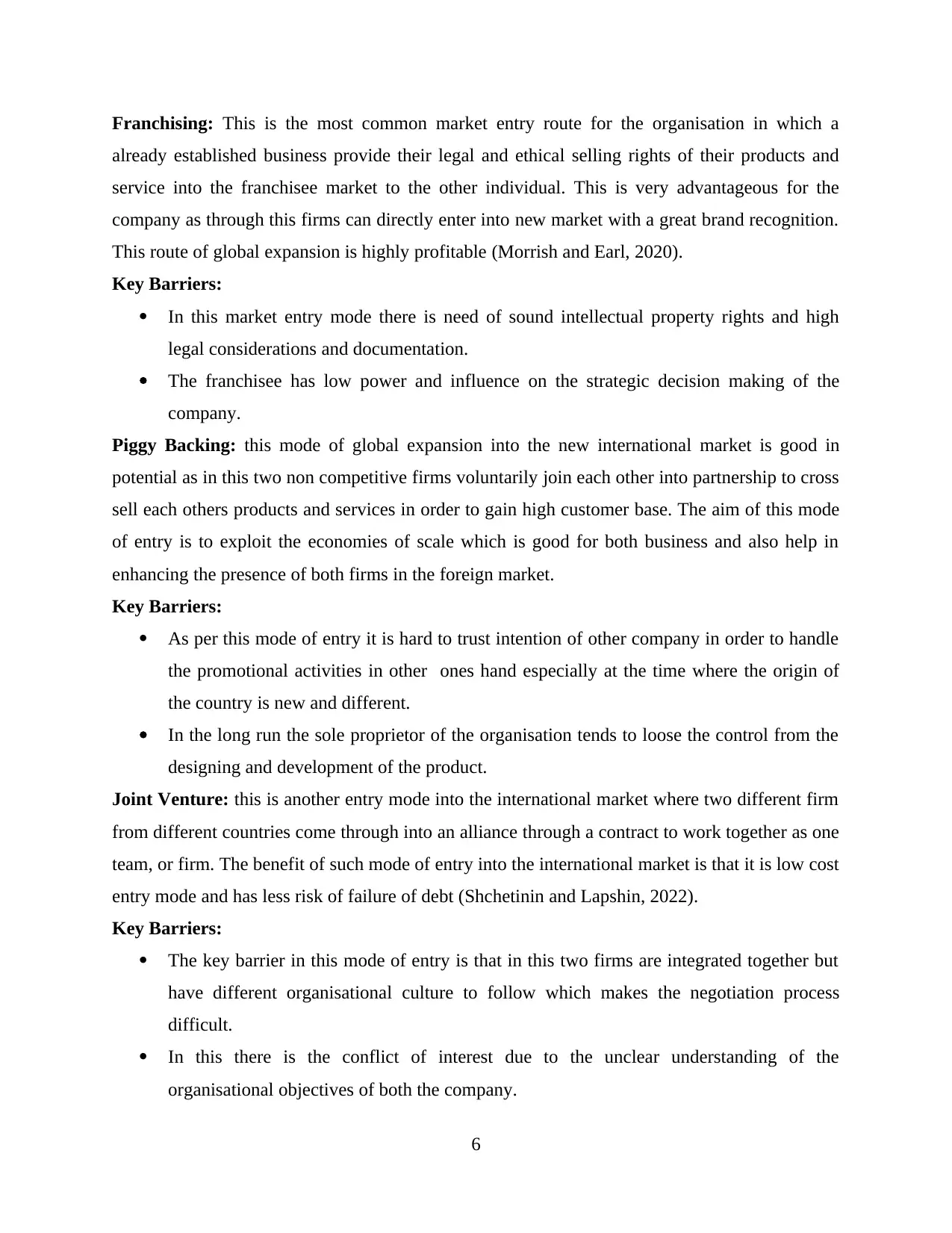
Franchising: This is the most common market entry route for the organisation in which a
already established business provide their legal and ethical selling rights of their products and
service into the franchisee market to the other individual. This is very advantageous for the
company as through this firms can directly enter into new market with a great brand recognition.
This route of global expansion is highly profitable (Morrish and Earl, 2020).
Key Barriers:
In this market entry mode there is need of sound intellectual property rights and high
legal considerations and documentation.
The franchisee has low power and influence on the strategic decision making of the
company.
Piggy Backing: this mode of global expansion into the new international market is good in
potential as in this two non competitive firms voluntarily join each other into partnership to cross
sell each others products and services in order to gain high customer base. The aim of this mode
of entry is to exploit the economies of scale which is good for both business and also help in
enhancing the presence of both firms in the foreign market.
Key Barriers:
As per this mode of entry it is hard to trust intention of other company in order to handle
the promotional activities in other ones hand especially at the time where the origin of
the country is new and different.
In the long run the sole proprietor of the organisation tends to loose the control from the
designing and development of the product.
Joint Venture: this is another entry mode into the international market where two different firm
from different countries come through into an alliance through a contract to work together as one
team, or firm. The benefit of such mode of entry into the international market is that it is low cost
entry mode and has less risk of failure of debt (Shchetinin and Lapshin, 2022).
Key Barriers:
The key barrier in this mode of entry is that in this two firms are integrated together but
have different organisational culture to follow which makes the negotiation process
difficult.
In this there is the conflict of interest due to the unclear understanding of the
organisational objectives of both the company.
6
already established business provide their legal and ethical selling rights of their products and
service into the franchisee market to the other individual. This is very advantageous for the
company as through this firms can directly enter into new market with a great brand recognition.
This route of global expansion is highly profitable (Morrish and Earl, 2020).
Key Barriers:
In this market entry mode there is need of sound intellectual property rights and high
legal considerations and documentation.
The franchisee has low power and influence on the strategic decision making of the
company.
Piggy Backing: this mode of global expansion into the new international market is good in
potential as in this two non competitive firms voluntarily join each other into partnership to cross
sell each others products and services in order to gain high customer base. The aim of this mode
of entry is to exploit the economies of scale which is good for both business and also help in
enhancing the presence of both firms in the foreign market.
Key Barriers:
As per this mode of entry it is hard to trust intention of other company in order to handle
the promotional activities in other ones hand especially at the time where the origin of
the country is new and different.
In the long run the sole proprietor of the organisation tends to loose the control from the
designing and development of the product.
Joint Venture: this is another entry mode into the international market where two different firm
from different countries come through into an alliance through a contract to work together as one
team, or firm. The benefit of such mode of entry into the international market is that it is low cost
entry mode and has less risk of failure of debt (Shchetinin and Lapshin, 2022).
Key Barriers:
The key barrier in this mode of entry is that in this two firms are integrated together but
have different organisational culture to follow which makes the negotiation process
difficult.
In this there is the conflict of interest due to the unclear understanding of the
organisational objectives of both the company.
6
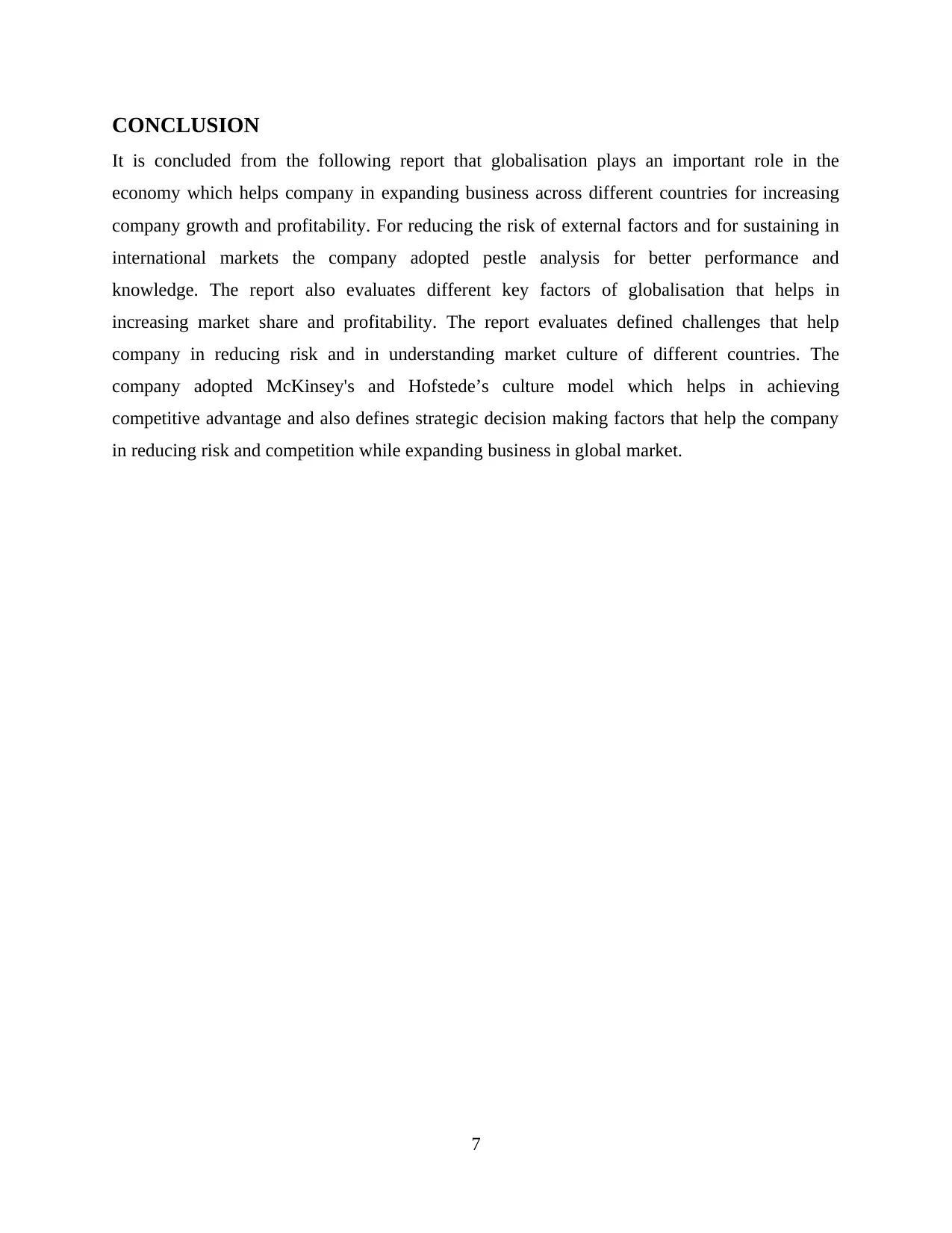
CONCLUSION
It is concluded from the following report that globalisation plays an important role in the
economy which helps company in expanding business across different countries for increasing
company growth and profitability. For reducing the risk of external factors and for sustaining in
international markets the company adopted pestle analysis for better performance and
knowledge. The report also evaluates different key factors of globalisation that helps in
increasing market share and profitability. The report evaluates defined challenges that help
company in reducing risk and in understanding market culture of different countries. The
company adopted McKinsey's and Hofstede’s culture model which helps in achieving
competitive advantage and also defines strategic decision making factors that help the company
in reducing risk and competition while expanding business in global market.
7
It is concluded from the following report that globalisation plays an important role in the
economy which helps company in expanding business across different countries for increasing
company growth and profitability. For reducing the risk of external factors and for sustaining in
international markets the company adopted pestle analysis for better performance and
knowledge. The report also evaluates different key factors of globalisation that helps in
increasing market share and profitability. The report evaluates defined challenges that help
company in reducing risk and in understanding market culture of different countries. The
company adopted McKinsey's and Hofstede’s culture model which helps in achieving
competitive advantage and also defines strategic decision making factors that help the company
in reducing risk and competition while expanding business in global market.
7
⊘ This is a preview!⊘
Do you want full access?
Subscribe today to unlock all pages.

Trusted by 1+ million students worldwide
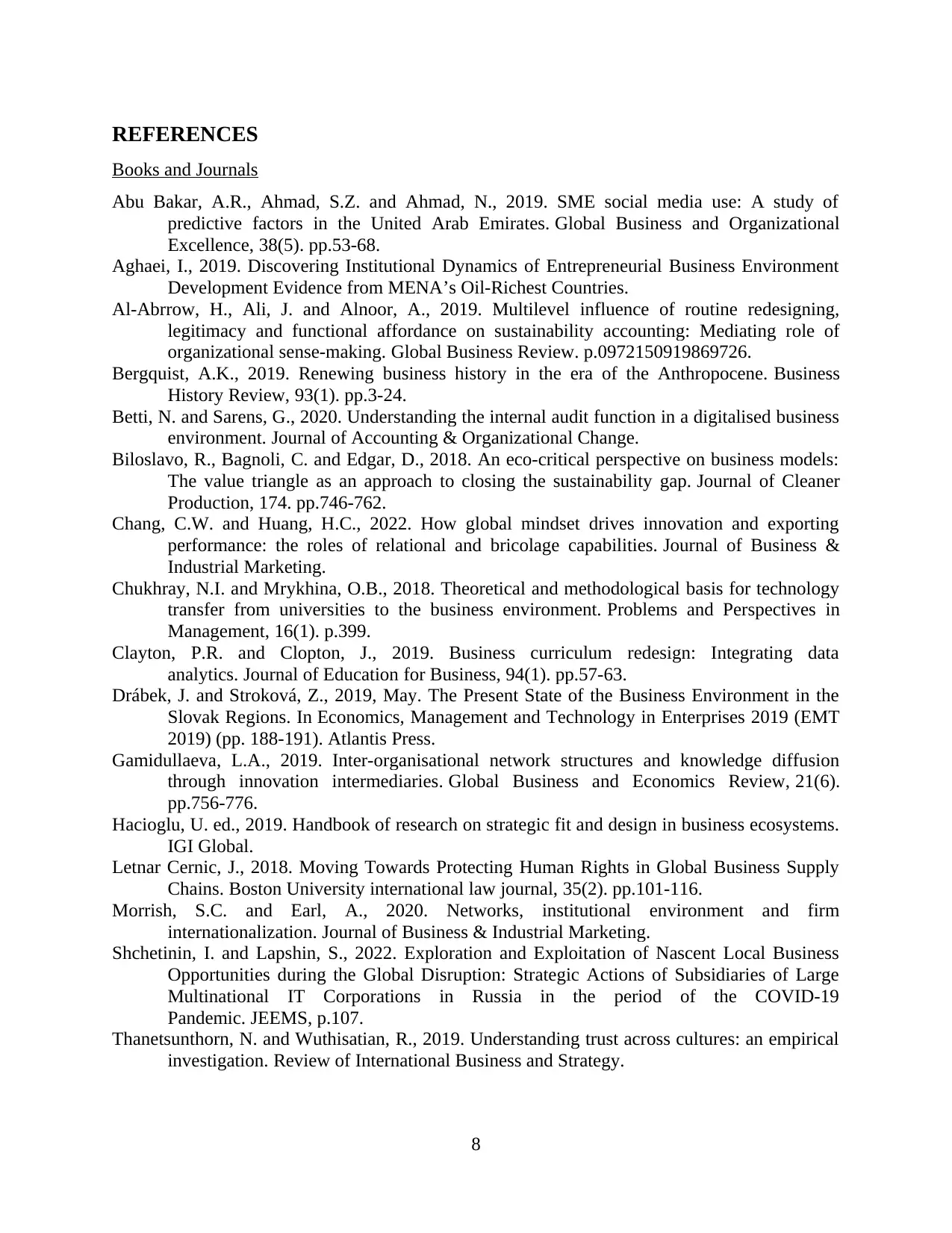
REFERENCES
Books and Journals
Abu Bakar, A.R., Ahmad, S.Z. and Ahmad, N., 2019. SME social media use: A study of
predictive factors in the United Arab Emirates. Global Business and Organizational
Excellence, 38(5). pp.53-68.
Aghaei, I., 2019. Discovering Institutional Dynamics of Entrepreneurial Business Environment
Development Evidence from MENA’s Oil-Richest Countries.
Al-Abrrow, H., Ali, J. and Alnoor, A., 2019. Multilevel influence of routine redesigning,
legitimacy and functional affordance on sustainability accounting: Mediating role of
organizational sense-making. Global Business Review. p.0972150919869726.
Bergquist, A.K., 2019. Renewing business history in the era of the Anthropocene. Business
History Review, 93(1). pp.3-24.
Betti, N. and Sarens, G., 2020. Understanding the internal audit function in a digitalised business
environment. Journal of Accounting & Organizational Change.
Biloslavo, R., Bagnoli, C. and Edgar, D., 2018. An eco-critical perspective on business models:
The value triangle as an approach to closing the sustainability gap. Journal of Cleaner
Production, 174. pp.746-762.
Chang, C.W. and Huang, H.C., 2022. How global mindset drives innovation and exporting
performance: the roles of relational and bricolage capabilities. Journal of Business &
Industrial Marketing.
Chukhray, N.I. and Mrykhina, O.B., 2018. Theoretical and methodological basis for technology
transfer from universities to the business environment. Problems and Perspectives in
Management, 16(1). p.399.
Clayton, P.R. and Clopton, J., 2019. Business curriculum redesign: Integrating data
analytics. Journal of Education for Business, 94(1). pp.57-63.
Drábek, J. and Stroková, Z., 2019, May. The Present State of the Business Environment in the
Slovak Regions. In Economics, Management and Technology in Enterprises 2019 (EMT
2019) (pp. 188-191). Atlantis Press.
Gamidullaeva, L.A., 2019. Inter-organisational network structures and knowledge diffusion
through innovation intermediaries. Global Business and Economics Review, 21(6).
pp.756-776.
Hacioglu, U. ed., 2019. Handbook of research on strategic fit and design in business ecosystems.
IGI Global.
Letnar Cernic, J., 2018. Moving Towards Protecting Human Rights in Global Business Supply
Chains. Boston University international law journal, 35(2). pp.101-116.
Morrish, S.C. and Earl, A., 2020. Networks, institutional environment and firm
internationalization. Journal of Business & Industrial Marketing.
Shchetinin, I. and Lapshin, S., 2022. Exploration and Exploitation of Nascent Local Business
Opportunities during the Global Disruption: Strategic Actions of Subsidiaries of Large
Multinational IT Corporations in Russia in the period of the COVID-19
Pandemic. JEEMS, p.107.
Thanetsunthorn, N. and Wuthisatian, R., 2019. Understanding trust across cultures: an empirical
investigation. Review of International Business and Strategy.
8
Books and Journals
Abu Bakar, A.R., Ahmad, S.Z. and Ahmad, N., 2019. SME social media use: A study of
predictive factors in the United Arab Emirates. Global Business and Organizational
Excellence, 38(5). pp.53-68.
Aghaei, I., 2019. Discovering Institutional Dynamics of Entrepreneurial Business Environment
Development Evidence from MENA’s Oil-Richest Countries.
Al-Abrrow, H., Ali, J. and Alnoor, A., 2019. Multilevel influence of routine redesigning,
legitimacy and functional affordance on sustainability accounting: Mediating role of
organizational sense-making. Global Business Review. p.0972150919869726.
Bergquist, A.K., 2019. Renewing business history in the era of the Anthropocene. Business
History Review, 93(1). pp.3-24.
Betti, N. and Sarens, G., 2020. Understanding the internal audit function in a digitalised business
environment. Journal of Accounting & Organizational Change.
Biloslavo, R., Bagnoli, C. and Edgar, D., 2018. An eco-critical perspective on business models:
The value triangle as an approach to closing the sustainability gap. Journal of Cleaner
Production, 174. pp.746-762.
Chang, C.W. and Huang, H.C., 2022. How global mindset drives innovation and exporting
performance: the roles of relational and bricolage capabilities. Journal of Business &
Industrial Marketing.
Chukhray, N.I. and Mrykhina, O.B., 2018. Theoretical and methodological basis for technology
transfer from universities to the business environment. Problems and Perspectives in
Management, 16(1). p.399.
Clayton, P.R. and Clopton, J., 2019. Business curriculum redesign: Integrating data
analytics. Journal of Education for Business, 94(1). pp.57-63.
Drábek, J. and Stroková, Z., 2019, May. The Present State of the Business Environment in the
Slovak Regions. In Economics, Management and Technology in Enterprises 2019 (EMT
2019) (pp. 188-191). Atlantis Press.
Gamidullaeva, L.A., 2019. Inter-organisational network structures and knowledge diffusion
through innovation intermediaries. Global Business and Economics Review, 21(6).
pp.756-776.
Hacioglu, U. ed., 2019. Handbook of research on strategic fit and design in business ecosystems.
IGI Global.
Letnar Cernic, J., 2018. Moving Towards Protecting Human Rights in Global Business Supply
Chains. Boston University international law journal, 35(2). pp.101-116.
Morrish, S.C. and Earl, A., 2020. Networks, institutional environment and firm
internationalization. Journal of Business & Industrial Marketing.
Shchetinin, I. and Lapshin, S., 2022. Exploration and Exploitation of Nascent Local Business
Opportunities during the Global Disruption: Strategic Actions of Subsidiaries of Large
Multinational IT Corporations in Russia in the period of the COVID-19
Pandemic. JEEMS, p.107.
Thanetsunthorn, N. and Wuthisatian, R., 2019. Understanding trust across cultures: an empirical
investigation. Review of International Business and Strategy.
8
Paraphrase This Document
Need a fresh take? Get an instant paraphrase of this document with our AI Paraphraser
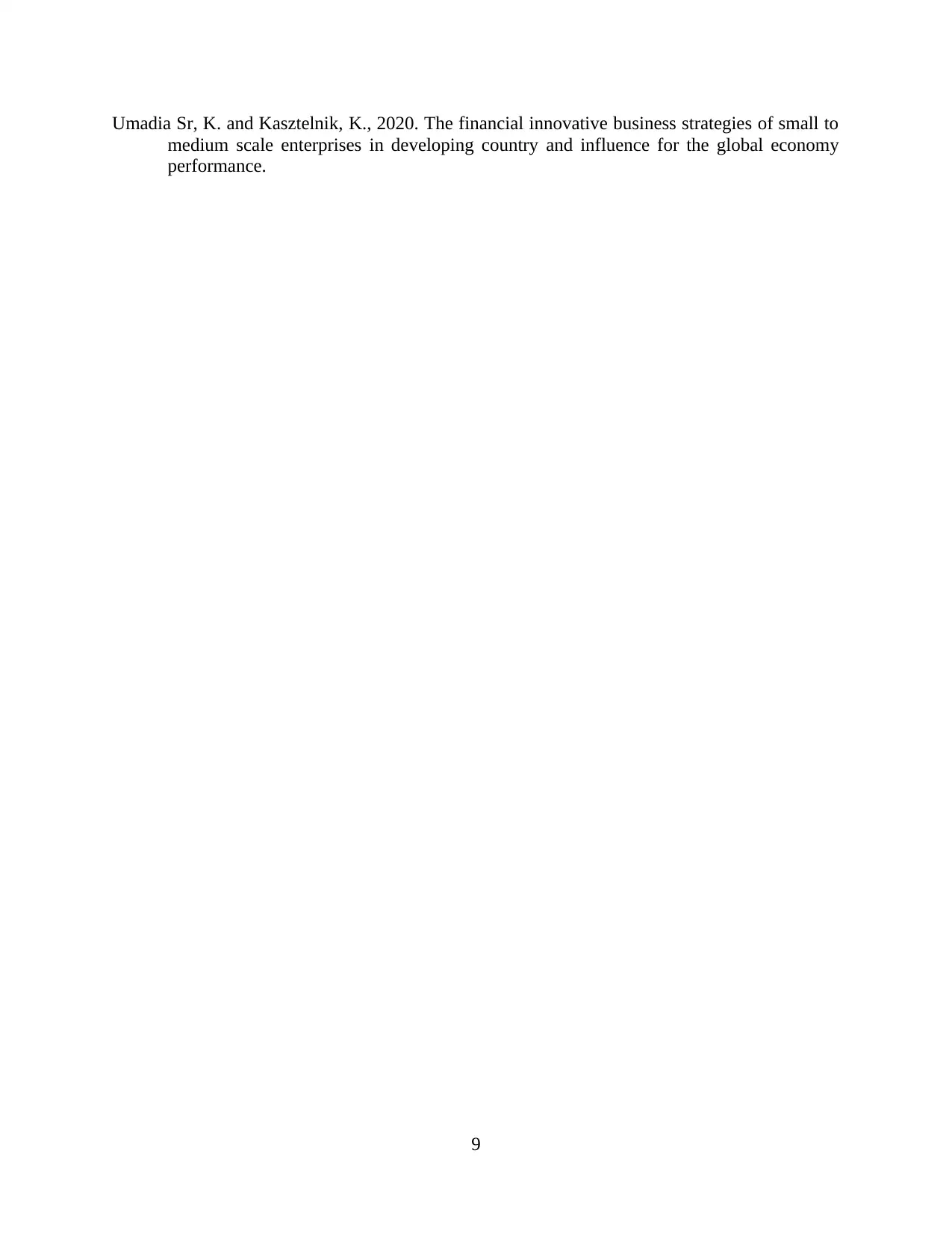
Umadia Sr, K. and Kasztelnik, K., 2020. The financial innovative business strategies of small to
medium scale enterprises in developing country and influence for the global economy
performance.
9
medium scale enterprises in developing country and influence for the global economy
performance.
9
1 out of 11
Related Documents
Your All-in-One AI-Powered Toolkit for Academic Success.
+13062052269
info@desklib.com
Available 24*7 on WhatsApp / Email
![[object Object]](/_next/static/media/star-bottom.7253800d.svg)
Unlock your academic potential
Copyright © 2020–2025 A2Z Services. All Rights Reserved. Developed and managed by ZUCOL.





